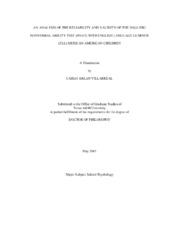| dc.contributor.advisor | Ash, Michael J. | |
| dc.contributor.advisor | Ochoa, Salvador Hector | |
| dc.creator | Villarreal, Carlo Arlan | |
| dc.date.accessioned | 2006-08-16T19:06:16Z | |
| dc.date.available | 2006-08-16T19:06:16Z | |
| dc.date.created | 2003-05 | |
| dc.date.issued | 2006-08-16 | |
| dc.identifier.uri | https://hdl.handle.net/1969.1/3850 | |
| dc.description.abstract | The purpose of this study was to investigate the reliability and validity of the
results of the Naglieri Nonverbal Ability Test (NNAT; Naglieri, 1997a) with a sample of
English Language Learner (ELL) Mexican American children and to compare the
performance on the NNAT of 122 ELL Mexican American children with children from
the standardization sample. The rationale for conducting this study was the need to
identify culturally sensitive and technically adequate nonverbal measures of ability for
the fastest growing minority group within AmericaÂ’s public schools today, Mexican
American children. The NNAT was administered to participants with parental consent.
Statistical analyses of the scores did yield positive evidence of internal consistency for
the Nonverbal Ability Index (NAI) total score of the NNAT. However, when individual
clusters were analyzed, Pattern Completion, Reasoning by Analogy, and Serial
Reasoning did not yield positive evidence of internal consistency. Only Spatial
Visualization approached the reliability standard deemed acceptable for tests of cognitive
ability. The mean differences of the NNAT scores between two independent groups
were also assessed in the present study. Results of the statistical analyses did not yield
statistically significant differences across age and grade factors between the scores of the
ELL Mexican American sample and the standardization sample. Finally, the proposed
factor structure of the NNAT was compared with the factor structure found with the ELL
Mexican American sample. Goodness-of-fit test statistics indicate that the proposed
four-factor structure does not fit well with the data obtained from this sample of ELL
Mexican American students. Furthermore, although the NNAT is considered to be a unidimensional test of general ability, nine factors were extracted upon analysis,
providing evidence that the items on each of the four clusters do not function together as
four distinct dimensions with this ELL Mexican American sample. Given that the
individual clusters that collectively combine to yield the NAI total score are not based on
any particular model of intelligence, interpretation of specific strengths and weaknesses
should be discouraged. Finally, the NNATÂ’s overall score should be interpreted with
caution and may best be used in conjunction with multidimensional ability and/or
intelligence measures. | en |
| dc.format.extent | 383122 bytes | en |
| dc.format.medium | electronic | en |
| dc.format.mimetype | application/pdf | |
| dc.language.iso | en_US | |
| dc.publisher | Texas A&M University | |
| dc.subject | Naglieri Nonverbal Ability Test | en |
| dc.subject | English Language Learners | en |
| dc.subject | Mexican American Children | en |
| dc.subject | Nonverbal Tests of Intelligence | en |
| dc.title | An analysis of the reliability and validity of the Naglieri Nonverbal Ability Test (NNAT) with English language Learner (ELL) Mexican American children | en |
| dc.type | Book | en |
| dc.type | Thesis | en |
| thesis.degree.department | Educational Psychology | en |
| thesis.degree.discipline | School Psychology | en |
| thesis.degree.grantor | Texas A&M University | en |
| thesis.degree.name | Doctor of Philosophy | en |
| thesis.degree.level | Doctoral | en |
| dc.contributor.committeeMember | Saenz, Rogelio | |
| dc.contributor.committeeMember | Willson, Victor | |
| dc.type.genre | Electronic Dissertation | en |
| dc.type.material | text | en |
| dc.format.digitalOrigin | born digital | en |


